Digital Control Systems Report
VerifiedAdded on 2020/03/13
|8
|1460
|307
Report
AI Summary
This report delves into the intricacies of Digital Control Systems, covering essential components, modes of control, and the advantages of advanced controls. It discusses data types, flow, and sources, as well as the construction of basic controllers. The report highlights the benefits of advanced controls in reducing operating costs and improving production consistency, while also explaining the differences between notified status and change detect points. Additionally, it outlines the purpose of sequence programs in executing instructions efficiently.
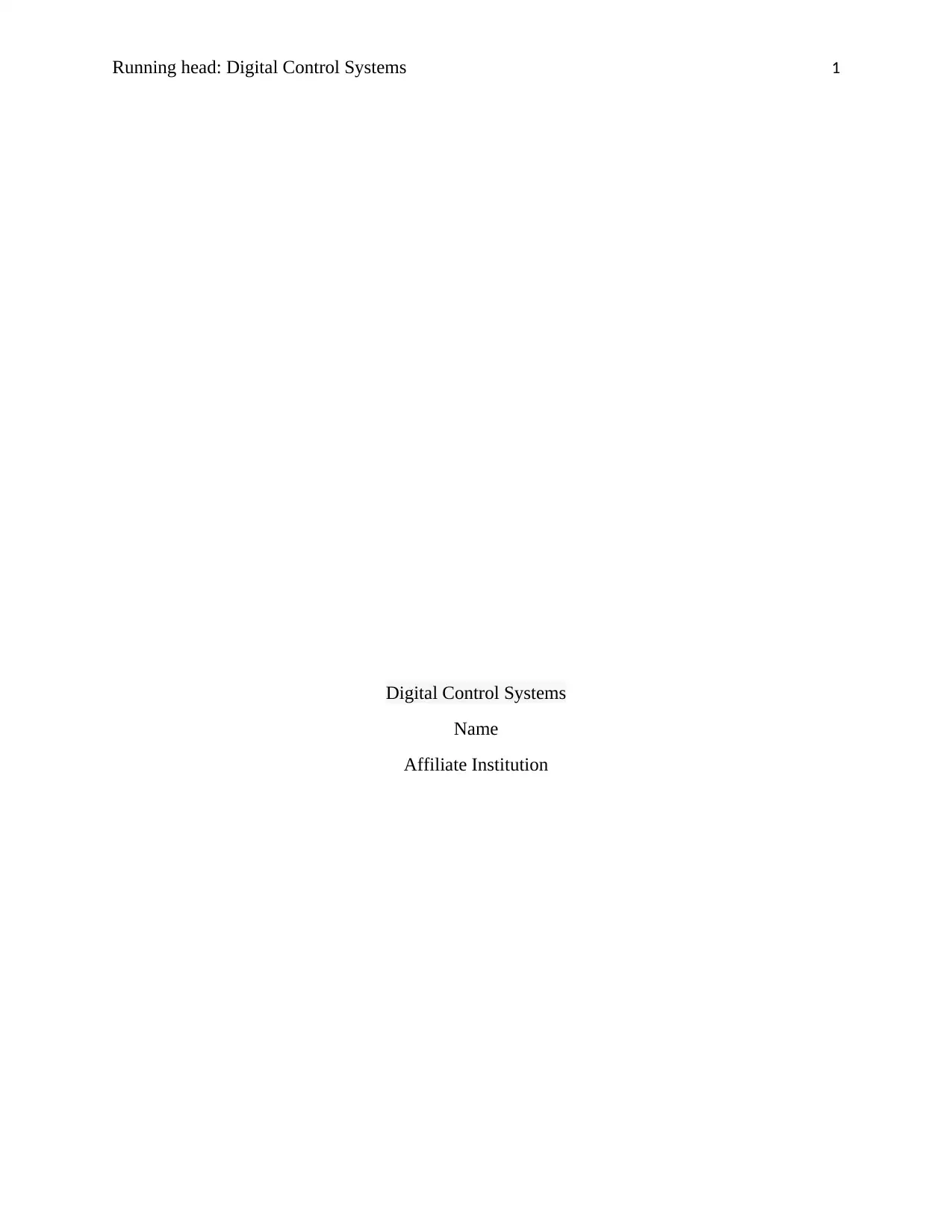
Running head: Digital Control Systems 1
Digital Control Systems
Name
Affiliate Institution
Digital Control Systems
Name
Affiliate Institution
Secure Best Marks with AI Grader
Need help grading? Try our AI Grader for instant feedback on your assignments.
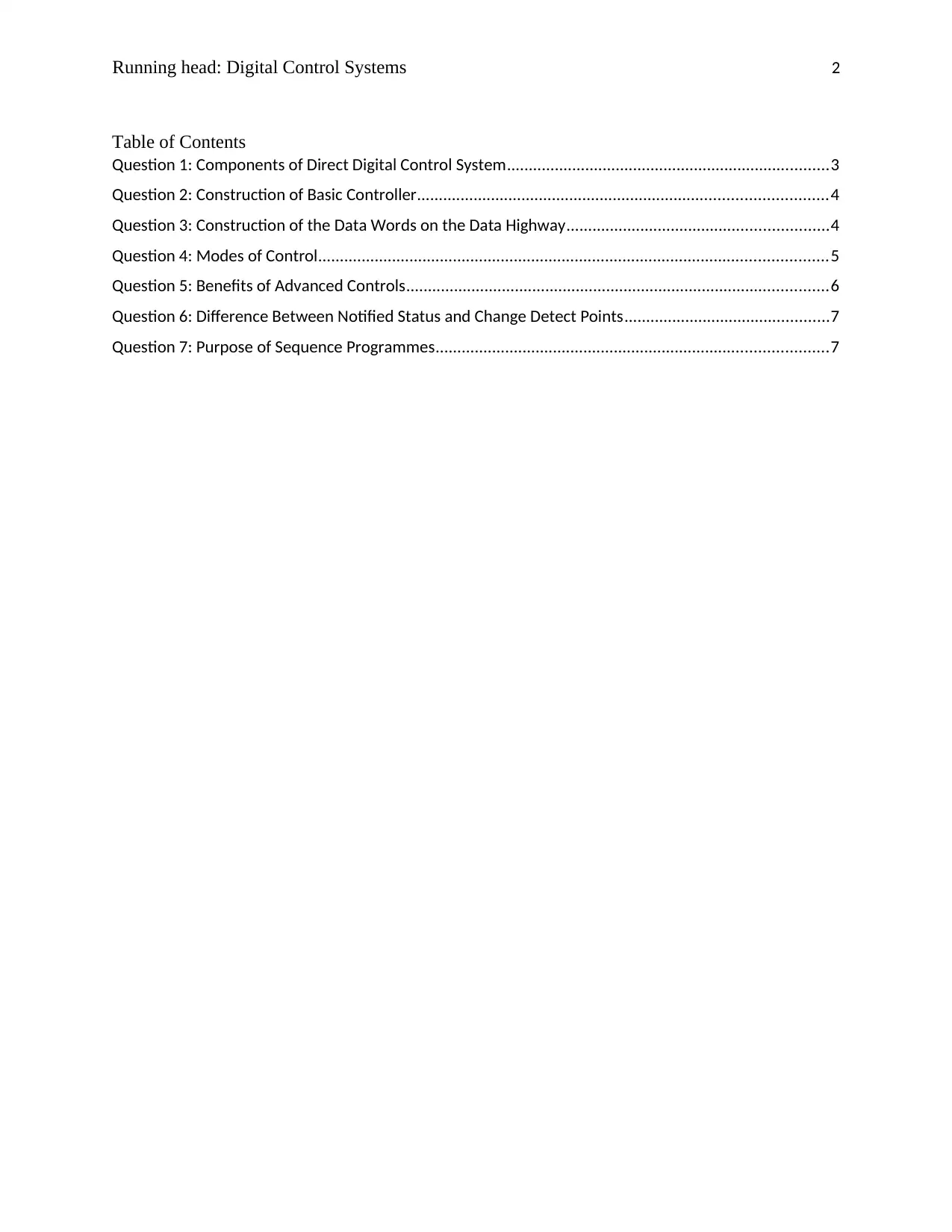
Running head: Digital Control Systems 2
Table of Contents
Question 1: Components of Direct Digital Control System..........................................................................3
Question 2: Construction of Basic Controller..............................................................................................4
Question 3: Construction of the Data Words on the Data Highway............................................................4
Question 4: Modes of Control.....................................................................................................................5
Question 5: Benefits of Advanced Controls.................................................................................................6
Question 6: Difference Between Notified Status and Change Detect Points...............................................7
Question 7: Purpose of Sequence Programmes..........................................................................................7
Table of Contents
Question 1: Components of Direct Digital Control System..........................................................................3
Question 2: Construction of Basic Controller..............................................................................................4
Question 3: Construction of the Data Words on the Data Highway............................................................4
Question 4: Modes of Control.....................................................................................................................5
Question 5: Benefits of Advanced Controls.................................................................................................6
Question 6: Difference Between Notified Status and Change Detect Points...............................................7
Question 7: Purpose of Sequence Programmes..........................................................................................7
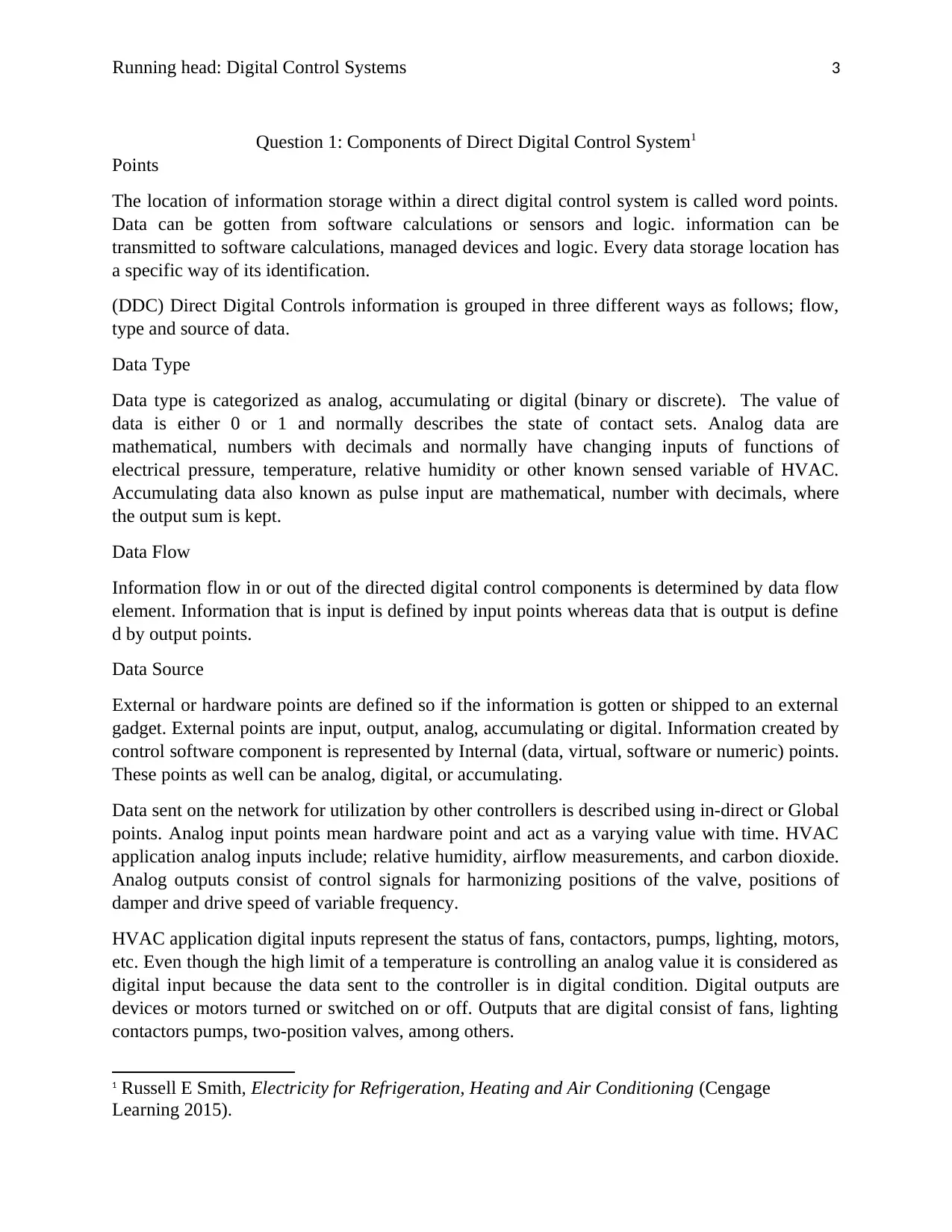
Running head: Digital Control Systems 3
Question 1: Components of Direct Digital Control System1
Points
The location of information storage within a direct digital control system is called word points.
Data can be gotten from software calculations or sensors and logic. information can be
transmitted to software calculations, managed devices and logic. Every data storage location has
a specific way of its identification.
(DDC) Direct Digital Controls information is grouped in three different ways as follows; flow,
type and source of data.
Data Type
Data type is categorized as analog, accumulating or digital (binary or discrete). The value of
data is either 0 or 1 and normally describes the state of contact sets. Analog data are
mathematical, numbers with decimals and normally have changing inputs of functions of
electrical pressure, temperature, relative humidity or other known sensed variable of HVAC.
Accumulating data also known as pulse input are mathematical, number with decimals, where
the output sum is kept.
Data Flow
Information flow in or out of the directed digital control components is determined by data flow
element. Information that is input is defined by input points whereas data that is output is define
d by output points.
Data Source
External or hardware points are defined so if the information is gotten or shipped to an external
gadget. External points are input, output, analog, accumulating or digital. Information created by
control software component is represented by Internal (data, virtual, software or numeric) points.
These points as well can be analog, digital, or accumulating.
Data sent on the network for utilization by other controllers is described using in-direct or Global
points. Analog input points mean hardware point and act as a varying value with time. HVAC
application analog inputs include; relative humidity, airflow measurements, and carbon dioxide.
Analog outputs consist of control signals for harmonizing positions of the valve, positions of
damper and drive speed of variable frequency.
HVAC application digital inputs represent the status of fans, contactors, pumps, lighting, motors,
etc. Even though the high limit of a temperature is controlling an analog value it is considered as
digital input because the data sent to the controller is in digital condition. Digital outputs are
devices or motors turned or switched on or off. Outputs that are digital consist of fans, lighting
contactors pumps, two-position valves, among others.
1 Russell E Smith, Electricity for Refrigeration, Heating and Air Conditioning (Cengage
Learning 2015).
Question 1: Components of Direct Digital Control System1
Points
The location of information storage within a direct digital control system is called word points.
Data can be gotten from software calculations or sensors and logic. information can be
transmitted to software calculations, managed devices and logic. Every data storage location has
a specific way of its identification.
(DDC) Direct Digital Controls information is grouped in three different ways as follows; flow,
type and source of data.
Data Type
Data type is categorized as analog, accumulating or digital (binary or discrete). The value of
data is either 0 or 1 and normally describes the state of contact sets. Analog data are
mathematical, numbers with decimals and normally have changing inputs of functions of
electrical pressure, temperature, relative humidity or other known sensed variable of HVAC.
Accumulating data also known as pulse input are mathematical, number with decimals, where
the output sum is kept.
Data Flow
Information flow in or out of the directed digital control components is determined by data flow
element. Information that is input is defined by input points whereas data that is output is define
d by output points.
Data Source
External or hardware points are defined so if the information is gotten or shipped to an external
gadget. External points are input, output, analog, accumulating or digital. Information created by
control software component is represented by Internal (data, virtual, software or numeric) points.
These points as well can be analog, digital, or accumulating.
Data sent on the network for utilization by other controllers is described using in-direct or Global
points. Analog input points mean hardware point and act as a varying value with time. HVAC
application analog inputs include; relative humidity, airflow measurements, and carbon dioxide.
Analog outputs consist of control signals for harmonizing positions of the valve, positions of
damper and drive speed of variable frequency.
HVAC application digital inputs represent the status of fans, contactors, pumps, lighting, motors,
etc. Even though the high limit of a temperature is controlling an analog value it is considered as
digital input because the data sent to the controller is in digital condition. Digital outputs are
devices or motors turned or switched on or off. Outputs that are digital consist of fans, lighting
contactors pumps, two-position valves, among others.
1 Russell E Smith, Electricity for Refrigeration, Heating and Air Conditioning (Cengage
Learning 2015).
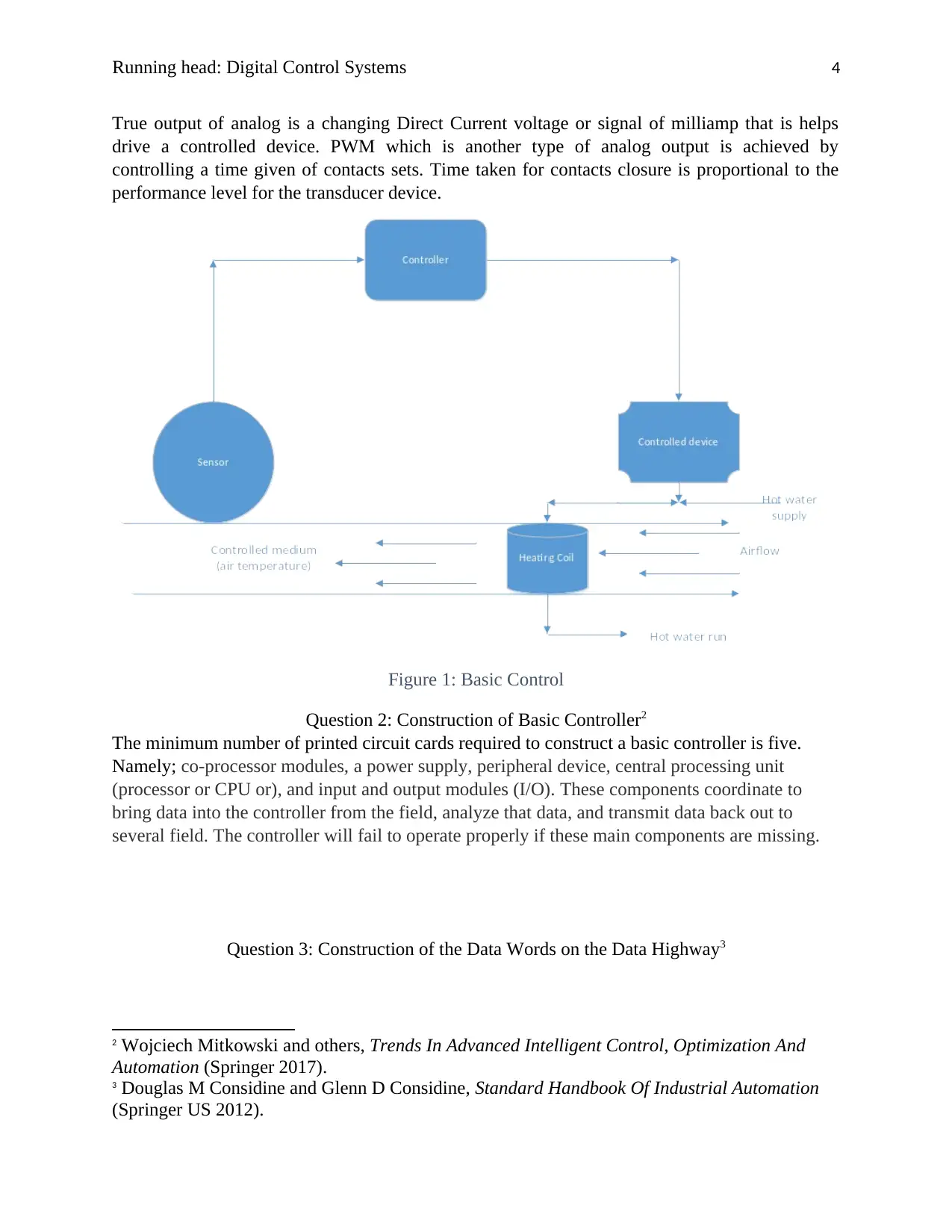
Running head: Digital Control Systems 4
True output of analog is a changing Direct Current voltage or signal of milliamp that is helps
drive a controlled device. PWM which is another type of analog output is achieved by
controlling a time given of contacts sets. Time taken for contacts closure is proportional to the
performance level for the transducer device.
Figure 1: Basic Control
Question 2: Construction of Basic Controller2
The minimum number of printed circuit cards required to construct a basic controller is five.
Namely; co-processor modules, a power supply, peripheral device, central processing unit
(processor or CPU or), and input and output modules (I/O). These components coordinate to
bring data into the controller from the field, analyze that data, and transmit data back out to
several field. The controller will fail to operate properly if these main components are missing.
Question 3: Construction of the Data Words on the Data Highway3
2 Wojciech Mitkowski and others, Trends In Advanced Intelligent Control, Optimization And
Automation (Springer 2017).
3 Douglas M Considine and Glenn D Considine, Standard Handbook Of Industrial Automation
(Springer US 2012).
True output of analog is a changing Direct Current voltage or signal of milliamp that is helps
drive a controlled device. PWM which is another type of analog output is achieved by
controlling a time given of contacts sets. Time taken for contacts closure is proportional to the
performance level for the transducer device.
Figure 1: Basic Control
Question 2: Construction of Basic Controller2
The minimum number of printed circuit cards required to construct a basic controller is five.
Namely; co-processor modules, a power supply, peripheral device, central processing unit
(processor or CPU or), and input and output modules (I/O). These components coordinate to
bring data into the controller from the field, analyze that data, and transmit data back out to
several field. The controller will fail to operate properly if these main components are missing.
Question 3: Construction of the Data Words on the Data Highway3
2 Wojciech Mitkowski and others, Trends In Advanced Intelligent Control, Optimization And
Automation (Springer 2017).
3 Douglas M Considine and Glenn D Considine, Standard Handbook Of Industrial Automation
(Springer US 2012).
Secure Best Marks with AI Grader
Need help grading? Try our AI Grader for instant feedback on your assignments.
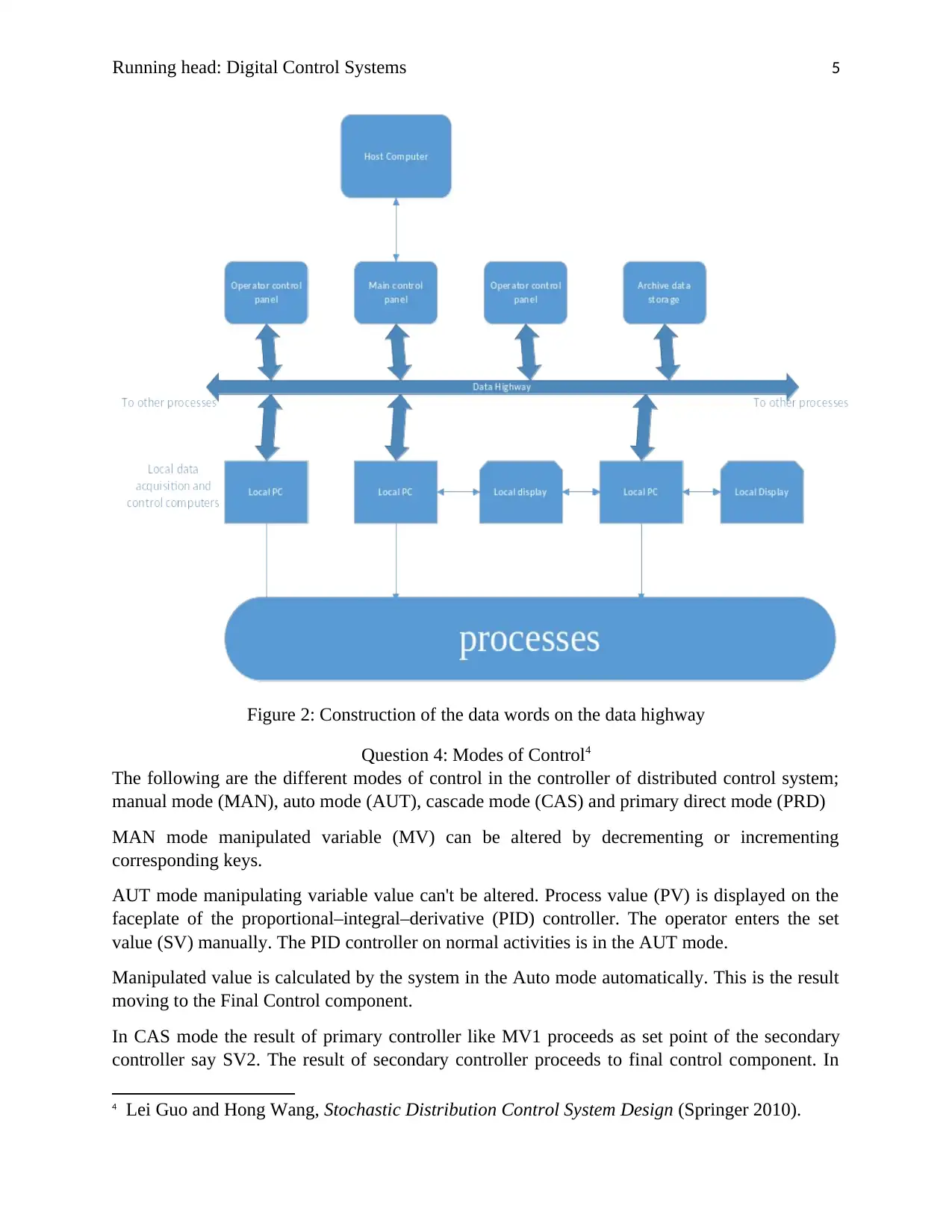
Running head: Digital Control Systems 5
Figure 2: Construction of the data words on the data highway
Question 4: Modes of Control4
The following are the different modes of control in the controller of distributed control system;
manual mode (MAN), auto mode (AUT), cascade mode (CAS) and primary direct mode (PRD)
MAN mode manipulated variable (MV) can be altered by decrementing or incrementing
corresponding keys.
AUT mode manipulating variable value can't be altered. Process value (PV) is displayed on the
faceplate of the proportional–integral–derivative (PID) controller. The operator enters the set
value (SV) manually. The PID controller on normal activities is in the AUT mode.
Manipulated value is calculated by the system in the Auto mode automatically. This is the result
moving to the Final Control component.
In CAS mode the result of primary controller like MV1 proceeds as set point of the secondary
controller say SV2. The result of secondary controller proceeds to final control component. In
4 Lei Guo and Hong Wang, Stochastic Distribution Control System Design (Springer 2010).
Figure 2: Construction of the data words on the data highway
Question 4: Modes of Control4
The following are the different modes of control in the controller of distributed control system;
manual mode (MAN), auto mode (AUT), cascade mode (CAS) and primary direct mode (PRD)
MAN mode manipulated variable (MV) can be altered by decrementing or incrementing
corresponding keys.
AUT mode manipulating variable value can't be altered. Process value (PV) is displayed on the
faceplate of the proportional–integral–derivative (PID) controller. The operator enters the set
value (SV) manually. The PID controller on normal activities is in the AUT mode.
Manipulated value is calculated by the system in the Auto mode automatically. This is the result
moving to the Final Control component.
In CAS mode the result of primary controller like MV1 proceeds as set point of the secondary
controller say SV2. The result of secondary controller proceeds to final control component. In
4 Lei Guo and Hong Wang, Stochastic Distribution Control System Design (Springer 2010).
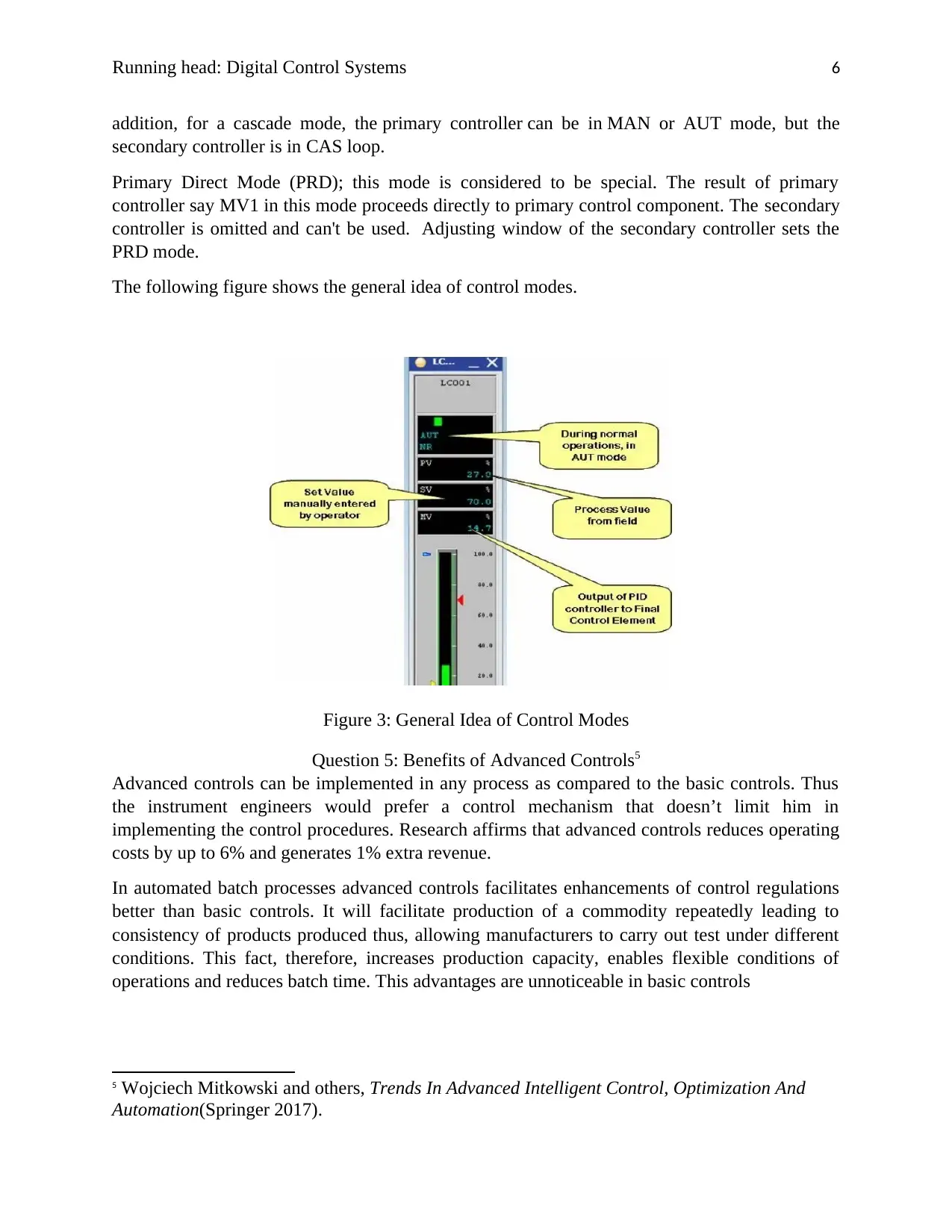
Running head: Digital Control Systems 6
addition, for a cascade mode, the primary controller can be in MAN or AUT mode, but the
secondary controller is in CAS loop.
Primary Direct Mode (PRD); this mode is considered to be special. The result of primary
controller say MV1 in this mode proceeds directly to primary control component. The secondary
controller is omitted and can't be used. Adjusting window of the secondary controller sets the
PRD mode.
The following figure shows the general idea of control modes.
Figure 3: General Idea of Control Modes
Question 5: Benefits of Advanced Controls5
Advanced controls can be implemented in any process as compared to the basic controls. Thus
the instrument engineers would prefer a control mechanism that doesn’t limit him in
implementing the control procedures. Research affirms that advanced controls reduces operating
costs by up to 6% and generates 1% extra revenue.
In automated batch processes advanced controls facilitates enhancements of control regulations
better than basic controls. It will facilitate production of a commodity repeatedly leading to
consistency of products produced thus, allowing manufacturers to carry out test under different
conditions. This fact, therefore, increases production capacity, enables flexible conditions of
operations and reduces batch time. This advantages are unnoticeable in basic controls
5 Wojciech Mitkowski and others, Trends In Advanced Intelligent Control, Optimization And
Automation(Springer 2017).
addition, for a cascade mode, the primary controller can be in MAN or AUT mode, but the
secondary controller is in CAS loop.
Primary Direct Mode (PRD); this mode is considered to be special. The result of primary
controller say MV1 in this mode proceeds directly to primary control component. The secondary
controller is omitted and can't be used. Adjusting window of the secondary controller sets the
PRD mode.
The following figure shows the general idea of control modes.
Figure 3: General Idea of Control Modes
Question 5: Benefits of Advanced Controls5
Advanced controls can be implemented in any process as compared to the basic controls. Thus
the instrument engineers would prefer a control mechanism that doesn’t limit him in
implementing the control procedures. Research affirms that advanced controls reduces operating
costs by up to 6% and generates 1% extra revenue.
In automated batch processes advanced controls facilitates enhancements of control regulations
better than basic controls. It will facilitate production of a commodity repeatedly leading to
consistency of products produced thus, allowing manufacturers to carry out test under different
conditions. This fact, therefore, increases production capacity, enables flexible conditions of
operations and reduces batch time. This advantages are unnoticeable in basic controls
5 Wojciech Mitkowski and others, Trends In Advanced Intelligent Control, Optimization And
Automation(Springer 2017).
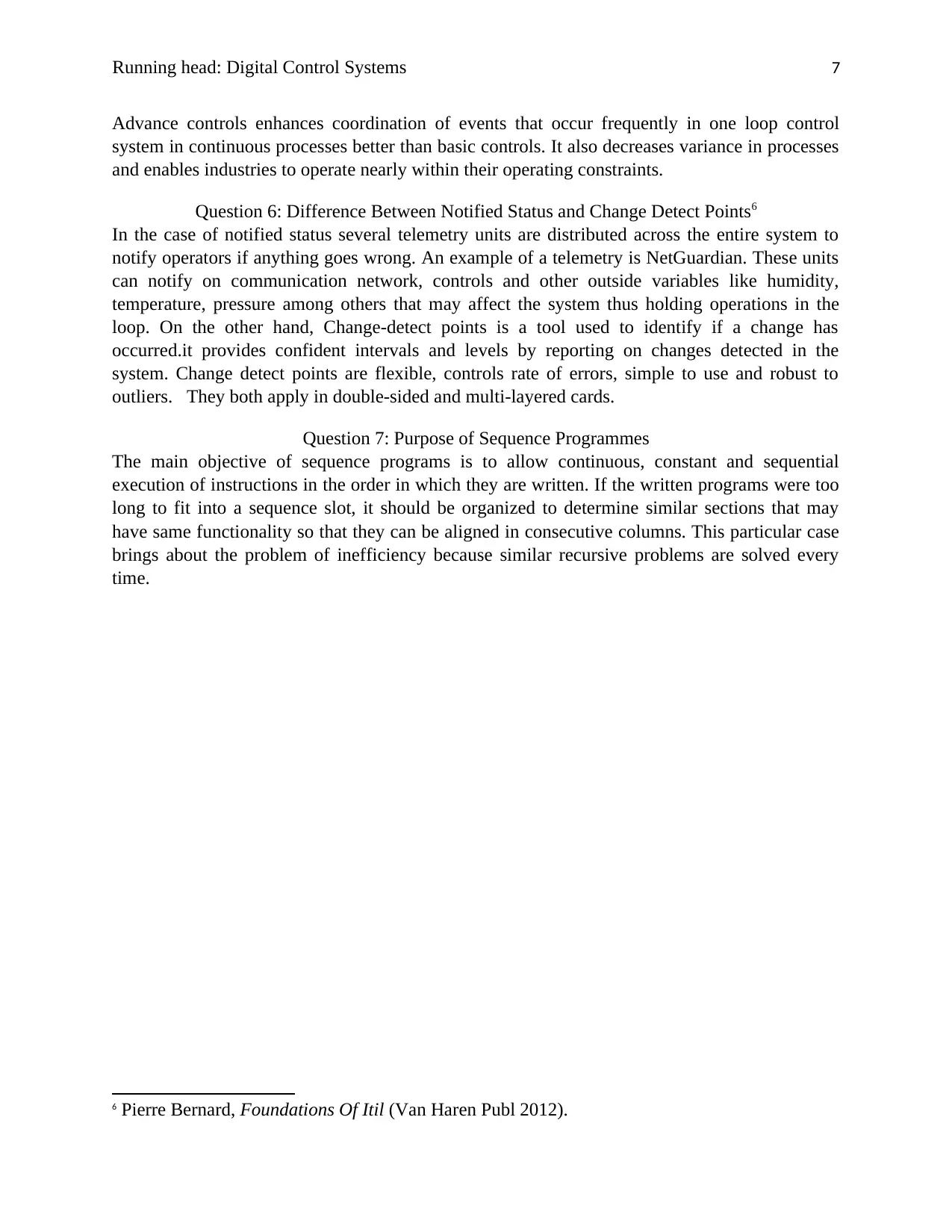
Running head: Digital Control Systems 7
Advance controls enhances coordination of events that occur frequently in one loop control
system in continuous processes better than basic controls. It also decreases variance in processes
and enables industries to operate nearly within their operating constraints.
Question 6: Difference Between Notified Status and Change Detect Points6
In the case of notified status several telemetry units are distributed across the entire system to
notify operators if anything goes wrong. An example of a telemetry is NetGuardian. These units
can notify on communication network, controls and other outside variables like humidity,
temperature, pressure among others that may affect the system thus holding operations in the
loop. On the other hand, Change-detect points is a tool used to identify if a change has
occurred.it provides confident intervals and levels by reporting on changes detected in the
system. Change detect points are flexible, controls rate of errors, simple to use and robust to
outliers. They both apply in double-sided and multi-layered cards.
Question 7: Purpose of Sequence Programmes
The main objective of sequence programs is to allow continuous, constant and sequential
execution of instructions in the order in which they are written. If the written programs were too
long to fit into a sequence slot, it should be organized to determine similar sections that may
have same functionality so that they can be aligned in consecutive columns. This particular case
brings about the problem of inefficiency because similar recursive problems are solved every
time.
6 Pierre Bernard, Foundations Of Itil (Van Haren Publ 2012).
Advance controls enhances coordination of events that occur frequently in one loop control
system in continuous processes better than basic controls. It also decreases variance in processes
and enables industries to operate nearly within their operating constraints.
Question 6: Difference Between Notified Status and Change Detect Points6
In the case of notified status several telemetry units are distributed across the entire system to
notify operators if anything goes wrong. An example of a telemetry is NetGuardian. These units
can notify on communication network, controls and other outside variables like humidity,
temperature, pressure among others that may affect the system thus holding operations in the
loop. On the other hand, Change-detect points is a tool used to identify if a change has
occurred.it provides confident intervals and levels by reporting on changes detected in the
system. Change detect points are flexible, controls rate of errors, simple to use and robust to
outliers. They both apply in double-sided and multi-layered cards.
Question 7: Purpose of Sequence Programmes
The main objective of sequence programs is to allow continuous, constant and sequential
execution of instructions in the order in which they are written. If the written programs were too
long to fit into a sequence slot, it should be organized to determine similar sections that may
have same functionality so that they can be aligned in consecutive columns. This particular case
brings about the problem of inefficiency because similar recursive problems are solved every
time.
6 Pierre Bernard, Foundations Of Itil (Van Haren Publ 2012).
Paraphrase This Document
Need a fresh take? Get an instant paraphrase of this document with our AI Paraphraser
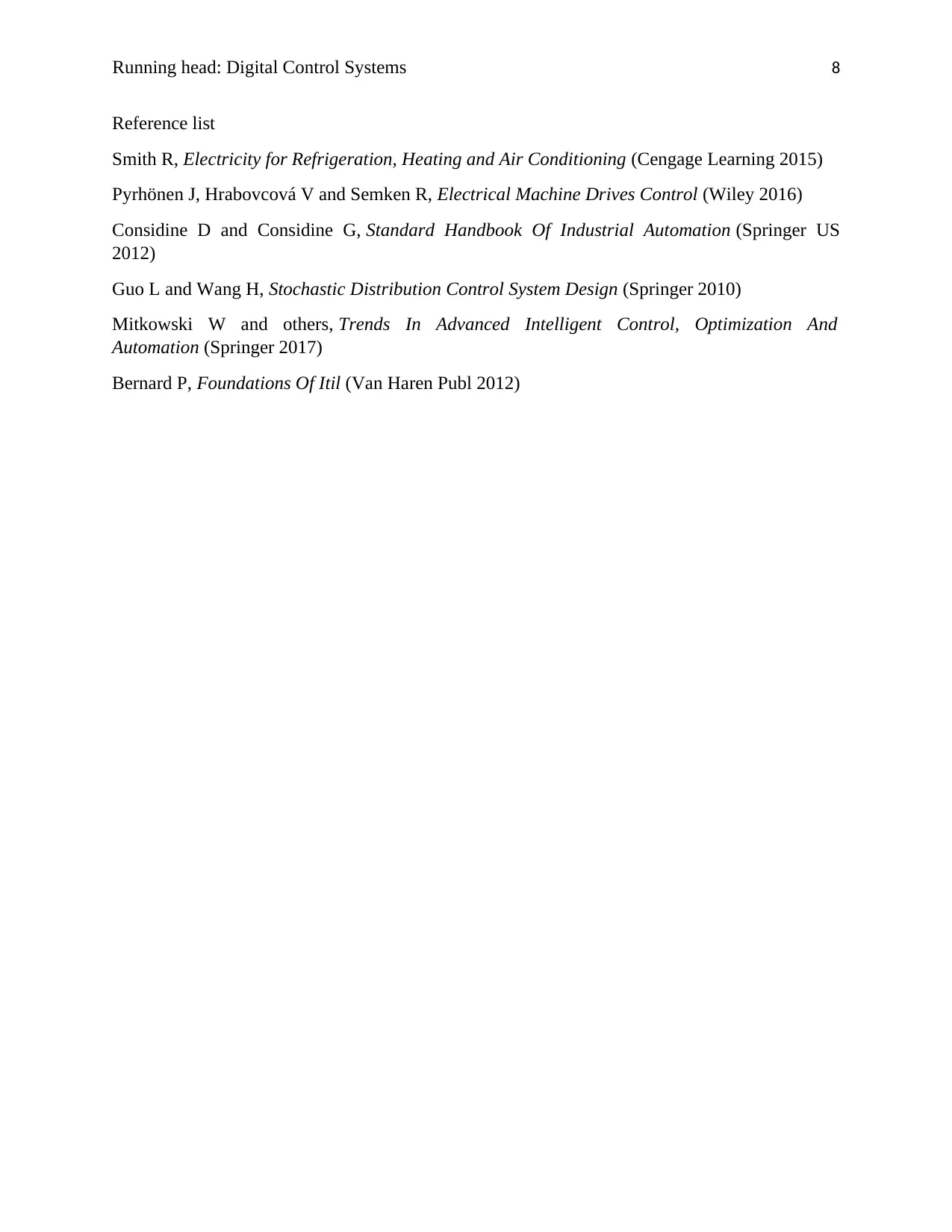
Running head: Digital Control Systems 8
Reference list
Smith R, Electricity for Refrigeration, Heating and Air Conditioning (Cengage Learning 2015)
Pyrhönen J, Hrabovcová V and Semken R, Electrical Machine Drives Control (Wiley 2016)
Considine D and Considine G, Standard Handbook Of Industrial Automation (Springer US
2012)
Guo L and Wang H, Stochastic Distribution Control System Design (Springer 2010)
Mitkowski W and others, Trends In Advanced Intelligent Control, Optimization And
Automation (Springer 2017)
Bernard P, Foundations Of Itil (Van Haren Publ 2012)
Reference list
Smith R, Electricity for Refrigeration, Heating and Air Conditioning (Cengage Learning 2015)
Pyrhönen J, Hrabovcová V and Semken R, Electrical Machine Drives Control (Wiley 2016)
Considine D and Considine G, Standard Handbook Of Industrial Automation (Springer US
2012)
Guo L and Wang H, Stochastic Distribution Control System Design (Springer 2010)
Mitkowski W and others, Trends In Advanced Intelligent Control, Optimization And
Automation (Springer 2017)
Bernard P, Foundations Of Itil (Van Haren Publ 2012)
1 out of 8
Your All-in-One AI-Powered Toolkit for Academic Success.
+13062052269
info@desklib.com
Available 24*7 on WhatsApp / Email
![[object Object]](/_next/static/media/star-bottom.7253800d.svg)
Unlock your academic potential
© 2024 | Zucol Services PVT LTD | All rights reserved.
